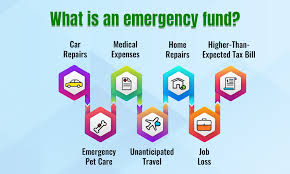The Importance of Emergency Funds
In today’s unpredictable financial landscape, the significance of maintaining an emergency fund cannot be overstated. An emergency fund serves as a crucial safety net, providing individuals with a cushion to navigate through unforeseen circumstances such as job loss, medical emergencies, or major unplanned expenses. The essence of an emergency fund lies in its ability to offer financial stability during turbulent times, supporting individuals in making informed decisions rather than hasty choices driven by immediate financial stress.
When an unexpected event occurs, such as a sudden layoff or an unexpected medical bill, having a set amount of money readily available allows individuals to respond without resorting to high-interest debt options, like credit cards or payday loans. It alleviates the pressure of immediate financial commitments, granting time to devise a plan for recovery. Thus, an emergency fund not only protects individuals from the ramifications of financial emergencies but also grants them the peace of mind essential for making sound decisions.
Moreover, the act of establishing an emergency fund fosters personal discipline and a proactive mindset towards financial management. As one accumulates savings for emergencies, it encourages the formation of healthy financial habits, such as budgeting and regular savings contributions. This preparation can transform financial behavior, resulting in increased overall financial literacy. Ultimately, when life throws unexpected challenges, the confidence derived from having an emergency fund can mitigate stress levels, enhancing overall well-being.
Essentially, an emergency fund embodies a fundamental pillar of sound financial planning. By prioritizing the establishment of a robust emergency savings account, individuals can not only prepare for the unexpected but also create a pathway toward longer-term financial health and stability. In this manner, an emergency fund is more than just savings; it’s a foundational element of a resilient financial future.
How Much Should You Save?
Determining the appropriate amount to save for an emergency fund is essential for maintaining financial stability. Experts often recommend that individuals set aside between three to six months’ worth of living expenses. This guideline serves as a buffer against unexpected financial setbacks, such as job loss or medical emergencies. However, the exact amount can vary significantly based on personal circumstances and individual financial responsibilities.
To begin calculating your emergency fund needs, it is crucial to have a detailed understanding of your monthly expenses. Start by listing all necessary costs, which typically include housing (rent or mortgage), utilities, food, transportation, healthcare, insurance, and minimum debt payments. Adding these baseline expenses will give you a clear idea of your monthly financial obligations. Once you’ve determined your total monthly expenses, multiply that figure by the desired number of months you wish to cover to establish a target savings goal.
Several factors can influence the final amount needed for your emergency fund. For instance, job stability plays a significant role; those in stable positions might lean towards the lower end of the savings spectrum, while individuals with fluctuating income or those in precarious industries may prefer to save more. Additionally, family size can impact financial obligations. Larger families generally incur higher monthly costs, possibly necessitating a larger fund. Other aspects, such as other personal financial responsibilities and any existing debt burden, should also be considered when determining your savings target.
Ultimately, your emergency fund should reflect your personal financial situation, ensuring that when the unexpected occurs, you are equipped to handle it without significant stress or disruption.
Where to Keep Your Emergency Fund
Establishing an emergency fund is a vital step in achieving financial stability. However, the location of this fund is equally important, as it can influence both accessibility and potential growth. To ensure optimum performance of your emergency savings, consider several types of accounts that offer a suitable balance between liquidity and safety.
One of the most recommended options for parking your emergency fund is a high-yield savings account. These accounts are typically offered by online banks and provide significantly higher interest rates compared to traditional savings accounts. This feature not only helps your savings to grow but also maintains their accessibility, allowing you to withdraw funds quickly in times of need.
Another viable option is a money market account. These accounts often blend features of savings and checking accounts, providing the ability to write checks or make electronic transfers while still earning a competitive interest rate. Money market accounts are ideal for those seeking both flexibility and the potential for modest growth. Nevertheless, it is essential to check any limitations on transactions, as they may restrict the number of withdrawals you can make in a month.
Additionally, consider keeping a portion of your emergency fund in a liquid, safe asset such as a Certificate of Deposit (CD) with a short-term maturity. CDs generally offer higher interest rates than regular savings accounts and are insured up to a certain limit. However, be cautious when opting for this route as funds may be inaccessible without incurring a penalty until the term ends.
Ultimately, the key to effectively managing your emergency fund lies in choosing accounts that allow for both growth and quick access. Evaluating your individual financial situation and liquidity needs will ensure that your emergency fund remains a reliable safety net during unforeseen circumstances.
Strategies for Building Your Emergency Fund Gradually
Establishing an emergency fund is a critical component of financial stability, yet many find it challenging to begin, especially if they are starting from scratch. One effective strategy for building your emergency fund gradually involves creating a well-structured budget. By analyzing your income and monthly expenses, you can identify areas where you can cut back. This should involve differentiating between essential and discretionary spending; essential expenses include rent and utilities, whereas discretionary items could encompass dining out or subscription services. Redirecting even a small portion of discretionary spending towards your emergency fund can result in significant savings over time.
Another practical tactic is implementing automatic transfers to your emergency fund. Once you have identified a specific amount you can afford to save, setting up an automatic transfer from your checking account to a separate savings account can simplify the process. This method minimizes the temptation to spend what you intend to save and establishes a consistent habit of saving, making contributions to your emergency fund feel less burdensome.
Additionally, consider adopting a mindset of continuous improvement in your financial habits. Periodically review your budget for areas where further adjustments may be possible. Unexpected windfalls, such as bonuses or tax refunds, can also significantly bolster your emergency fund. Allocating a portion or even the entirety of these sums can accelerate your progress toward your savings goals. Furthermore, consider ways to reduce unnecessary expenses—whether through couponing, seeking discounts, or downsizing your living arrangements. Embracing a gradual approach to building your emergency fund allows you to create a robust financial safety net without overwhelming your current financial situation.


